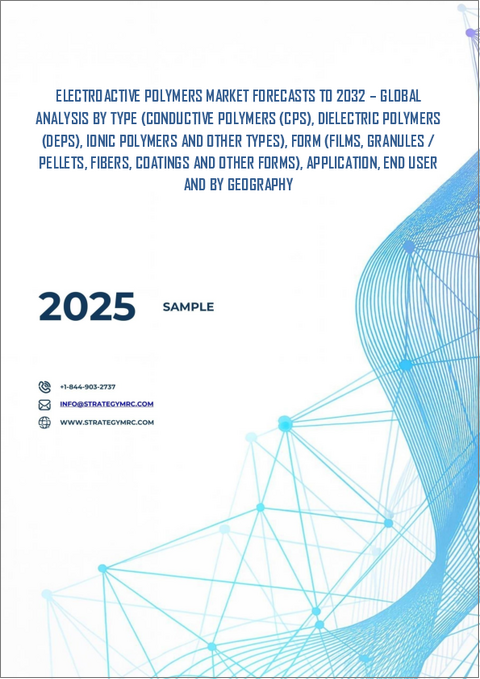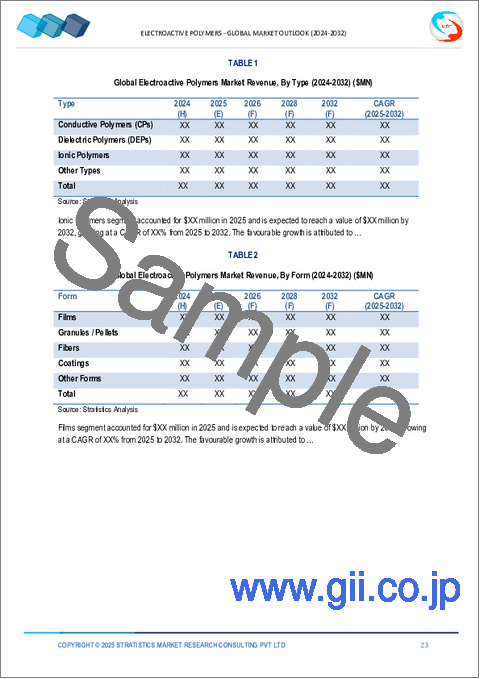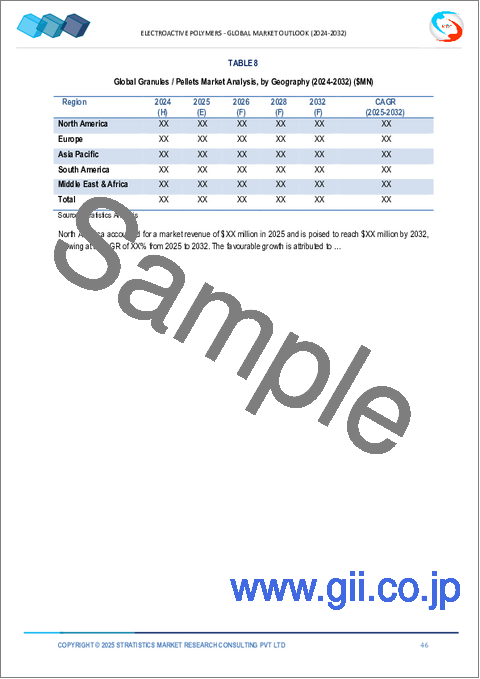|
|
市場調査レポート
商品コード
1803019
電気活性ポリマーの世界市場:将来予測 (2032年まで) - 種類別・形状別・用途別・エンドユーザー別・地域別の分析Electroactive Polymers Market Forecasts to 2032 - Global Analysis By Type (Conductive Polymers, Dielectric Polymers, Ionic Polymers and Other Types), Form, Application, End User and By Geography |
||||||
カスタマイズ可能
|
|||||||
| 電気活性ポリマーの世界市場:将来予測 (2032年まで) - 種類別・形状別・用途別・エンドユーザー別・地域別の分析 |
|
出版日: 2025年09月07日
発行: Stratistics Market Research Consulting
ページ情報: 英文 200+ Pages
納期: 2~3営業日
|
全表示
- 概要
- 図表
- 目次
Stratistics MRCによると、世界の電気活性ポリマー市場は2025年に60億3,000万米ドルを占め、予測期間中のCAGRは5.6%で成長し、2032年には88億3,000万米ドルに達する見込みです。
電気活性ポリマー(EAP)は、電気刺激に反応して機械的変形を示すスマート材料の一種です。これらのポリマーは電気エネルギーを運動に変換するため、アクチュエーター、センサー、人工筋肉に適しています。その軽量性、柔軟性、調整可能な特性により、ロボット工学、生体医療機器、適応システムへの応用が可能です。EAPは、その組成に応じてイオン性または電子性のメカニズムで機能します。現在進行中の研究は、高度な電気機械技術に統合するために、その効率性、耐久性、応答性を高めることに焦点を当てています。
Ceramics』(MDPI、2021年)に掲載された総説によると、電気活性ポリマー(EAP)は最大380%の機械的ひずみ応答を示すことができ、柔軟性と変形能力において従来の圧電セラミック・アクチュエータを大幅に上回る。
軽量で柔軟な素材への需要の高まり
EAP固有の柔軟性、軽量性、電気刺激に反応して変形する能力は、次世代のエレクトロニクスに理想的です。これは特に、ウェアラブル・テクノロジー、フレキシブル・ディスプレイ、電子テキスタイルなどの急成長分野で顕著であり、硬い部品がこうした「スマート」な材料に置き換えられつつあります。さらに、人間と安全に相互作用し、複雑な環境をナビゲートできるロボットの創造を目指すソフトロボティクスの登場は、生物学的な筋肉の動きを模倣したEAPアクチュエータにほぼ全面的に依存しています。
スケーラビリティを制限する複雑な合成・製造プロセス
電気活性ポリマーは、その有望な用途にもかかわらず、製造コストや統合コストが高いことが、普及の大きな障壁となっています。これらの材料は、高度な合成技術と特殊な装置を必要とすることが多く、製造コストが高くなります。さらに、医療や産業用途の規制基準を満たすための厳格な試験が必要なため、経済的な負担も大きくなります。中小企業は、資本や技術的専門知識へのアクセスが限られているため、競争に苦戦する可能性があります。
生分解性で環境に優しいEAPの研究増加
研究者たちは、EAPがシグナルに反応して治療薬を正確に放出することができる高度ドラッグデリバリーシステムや、EAPが細胞増殖を刺激し、生来の組織の機械的特性を模倣することができる組織再生用足場への利用を模索しています。この技術は、周囲の振動や動きからエネルギーを採取し、従来のバッテリーを不要にして、持続可能なワイヤレス・エレクトロニクスの新時代への道を開く、セルフパワー型のセンサーやデバイスの開発につながる可能性があります。
医療・エレクトロニクス用途に対する不透明な規制の枠組み
規制機関は、EAPを組み込んだ機器の保険適用を承認する前に、広範な臨床検証や費用対効果のデータを要求することが多いです。このため商業化が遅れ、特に診断や治療における新しい用途へのアクセスが制限されます。さらに、国によって償還政策に一貫性がないため、メーカーや投資家にとって不確実性が生じる。評価基準が標準化されていないため、技術革新が妨げられ、臨床現場での最先端技術の採用が阻害される可能性があります。
COVID-19の影響:
COVID-19の大流行は、電気活性ポリマー市場に二重の影響を与えました。一方では、サプライチェーンの混乱と産業活動の低下により、生産と展開が一時的に停滞しました。一方、この危機はスマート医療機器や遠隔監視ソリューションの需要を加速させ、EAPはそこで重要な役割を果たしました。ウェアラブルセンサーやフレキシブルエレクトロニクスへの統合は、分散型ヘルスケアへのシフトを支えました。さらに、抗ウイルスコーティングや応答性材料の研究が勢いを増し、EAP応用の新たな道が開かれました。
予測期間中、誘電性ポリマー(DEPs)分野が最大になる見込み
誘電性ポリマー(DEPs)セグメントは、導電性と軽量ポリマー特性のユニークな組み合わせにより、予測期間中最大の市場シェアを占めると予想されます。添加剤や充填剤に依存する他の導電性プラスチックとは異なり、ICPは共役ポリマー骨格を通じて本質的な導電性を有し、その結果、優れた性能と安定性を実現します。このため、フレキシブル・エレクトロニクス、帯電防止パッケージング、高感度電子部品のEMI/ESDシールドなど、幅広い用途で高い人気を誇っています。
人工筋肉・人工装具分野は予測期間中に最も高いCAGRが見込まれる
予測期間中、ロボット工学、医療機器、ハプティック・フィードバック・システムにおけるEAPの統合が進んでいることから、人工筋肉・人工装具分野が最も高い成長率を示すと予測されます。EAPベースのアクチュエータは、従来の電気機械式アクチュエータに比べて大きく高速な変形が可能で、軽量かつ柔軟性が高いため、ソフトで器用なロボットや本物そっくりの人工装具を作ることができます。同様に、EAPセンサーは高い感度と柔軟性を備えており、健康モニタリング・パッチ、スマート・テキスタイル、高度診断ツールに最適です。
最大のシェアを占める地域
予測期間中、アジア太平洋地域は、強固で確立された技術エコシステムに後押しされ、最大の市場シェアを占めると予想されます。EAPの主要消費者である航空宇宙産業、自動車産業、医療機器産業における主要企業の存在が大きな推進力となっています。これらの業界は研究開発に多額の投資を行っており、軽量航空機部品、スマート車両内装、高度医療用インプラントなどの用途で革新的な材料をいち早く採用しています。
CAGRが最も高い地域:
予測期間中、北米地域は急速な工業化と急成長するエレクトロニクスおよび製造部門に牽引され、最も高いCAGRを示すと予測されます。中国、韓国、日本のような国々は世界のエレクトロニクス生産の最前線にあり、フレキシブル・ディスプレイ、センサー、保護材料用のEAPに対する莫大な需要を牽引しています。さらに、特にロボット工学や生物医学工学の分野では、政府の取り組みや研究開発への投資がこの地域全体で増加しており、市場成長を促す環境が醸成されています。
無料のカスタマイズサービス
当レポートをご購読のお客様には、以下の無料カスタマイズオプションのいずれかをご利用いただけます:
- 企業プロファイル
- 追加企業の包括的プロファイリング(3社まで)
- 主要企業のSWOT分析(3社まで)
- 地域区分
- 顧客の関心に応じた主要国の市場推計・予測・CAGR(注:フィージビリティチェックによる)
- 競合ベンチマーキング
- 製品ポートフォリオ、地理的プレゼンス、戦略的提携に基づく主要企業のベンチマーキング
目次
第1章 エグゼクティブサマリー
第2章 序論
- 概要
- ステークホルダー
- 分析範囲
- 分析手法
- データマイニング
- データ分析
- データ検証
- 分析アプローチ
- 分析資料
- 一次調査資料
- 二次調査情報源
- 前提条件
第3章 市場動向の分析
- 促進要因
- 抑制要因
- 市場機会
- 脅威
- 用途分析
- 新興市場
- 新型コロナウイルス感染症 (COVID-19) の影響
第4章 ポーターのファイブフォース分析
- サプライヤーの交渉力
- バイヤーの交渉力
- 代替製品の脅威
- 新規参入企業の脅威
- 企業間競争
第5章 世界の電気活性ポリマー市場:種類別
- 導電性ポリマー(CP)
- 本質的に導電性のあるポリマー(ICP)
- ポリチオフェン
- ポリアニリン
- ポリピロール
- 本質的に散逸性のあるポリマー(IDP)
- 誘電ポリマー(DEP)
- 誘電エラストマー
- ポリフッ化ビニリデン(PVDF)
- 電歪グラフトエラストマー
- 強誘電体ポリマー
- PVDF-TrFE
- イオン性ポリマー
- イオン性ポリマー金属複合材料(IPMC)
- イオン性ポリマーゲル(IPG)
- その他の種類
第6章 世界の電気活性ポリマー市場:形状別
- フィルム
- 顆粒/ペレット
- 繊維
- コーティング
- その他の形式
第7章 世界の電気活性ポリマー市場:用途別
- アクチュエータとセンサー
- ESD・EMI保護
- 人工筋肉・義肢
- 生体模倣デバイス
- バイオセンサー・化学センサー
- 静電気放電保護
- 電磁干渉シールド
- ドラッグデリバリーシステム
- 帯電防止包装
- その他の用途
第8章 世界の電気活性ポリマー市場:エンドユーザー別
- 電気・電子
- 自動車・輸送
- 航空宇宙・防衛
- エネルギー・電力
- 産業オートメーション・ロボット工学
- その他のエンドユーザー
第9章 世界の電気活性ポリマー市場:地域別
- 北米
- 米国
- カナダ
- メキシコ
- 欧州
- ドイツ
- 英国
- イタリア
- フランス
- スペイン
- その他欧州
- アジア太平洋
- 日本
- 中国
- インド
- オーストラリア
- ニュージーランド
- 韓国
- その他アジア太平洋
- 南米
- アルゼンチン
- ブラジル
- チリ
- その他南米
- 中東・アフリカ
- サウジアラビア
- アラブ首長国連邦
- カタール
- 南アフリカ
- その他中東・アフリカ
第10章 主な動向
- 契約、事業提携・協力、合弁事業
- 企業合併・買収 (M&A)
- 新製品の発売
- 事業拡張
- その他の主要戦略
第11章 企業プロファイリング
- 3M Company
- Evonik Industries AG
- Wacker Chemie AG
- Arkema S.A.
- DuPont de Nemours, Inc.
- Parker Hannifin Corporation
- Bayer AG
- Solvay S.A.
- BASF SE
- RTP Company
- Agfa-Gevaert N.V.
- Merck KGaA
- Lubrizol Corporation
- Novasentis Inc.
- Premix Oy
- PolyOne Corporation
- Heraeus Group
- Momentive Performance Materials
- Datwyler Group
- BSC Computer GmbH
List of Tables
- Table 1 Global Electroactive Polymers Market Outlook, By Region (2024-2032) ($MN)
- Table 2 Global Electroactive Polymers Market Outlook, By Type (2024-2032) ($MN)
- Table 3 Global Electroactive Polymers Market Outlook, By Conductive Polymers (CPs) (2024-2032) ($MN)
- Table 4 Global Electroactive Polymers Market Outlook, By Inherently Conductive Polymers (ICPs) (2024-2032) ($MN)
- Table 5 Global Electroactive Polymers Market Outlook, By Polythiophenes (2024-2032) ($MN)
- Table 6 Global Electroactive Polymers Market Outlook, By Polyaniline (2024-2032) ($MN)
- Table 7 Global Electroactive Polymers Market Outlook, By Polypyrrole (2024-2032) ($MN)
- Table 8 Global Electroactive Polymers Market Outlook, By Inherently Dissipative Polymers (IDPs) (2024-2032) ($MN)
- Table 9 Global Electroactive Polymers Market Outlook, By Dielectric Polymers (DEPs) (2024-2032) ($MN)
- Table 10 Global Electroactive Polymers Market Outlook, By Dielectric Elastomers (2024-2032) ($MN)
- Table 11 Global Electroactive Polymers Market Outlook, By Polyvinylidene Fluoride (PVDF) (2024-2032) ($MN)
- Table 12 Global Electroactive Polymers Market Outlook, By Electrostrictive Graft Elastomers (2024-2032) ($MN)
- Table 13 Global Electroactive Polymers Market Outlook, By Ferroelectric Polymers (2024-2032) ($MN)
- Table 14 Global Electroactive Polymers Market Outlook, By PVDF-TrFE (2024-2032) ($MN)
- Table 15 Global Electroactive Polymers Market Outlook, By Ionic Polymers (2024-2032) ($MN)
- Table 16 Global Electroactive Polymers Market Outlook, By Ionic Polymer Metal Composites (IPMCs) (2024-2032) ($MN)
- Table 17 Global Electroactive Polymers Market Outlook, By Ionic Polymer Gels (IPGs) (2024-2032) ($MN)
- Table 18 Global Electroactive Polymers Market Outlook, By Other Types (2024-2032) ($MN)
- Table 19 Global Electroactive Polymers Market Outlook, By Form (2024-2032) ($MN)
- Table 20 Global Electroactive Polymers Market Outlook, By Films (2024-2032) ($MN)
- Table 21 Global Electroactive Polymers Market Outlook, By Granules / Pellets (2024-2032) ($MN)
- Table 22 Global Electroactive Polymers Market Outlook, By Fibers (2024-2032) ($MN)
- Table 23 Global Electroactive Polymers Market Outlook, By Coatings (2024-2032) ($MN)
- Table 24 Global Electroactive Polymers Market Outlook, By Other Forms (2024-2032) ($MN)
- Table 25 Global Electroactive Polymers Market Outlook, By Application (2024-2032) ($MN)
- Table 26 Global Electroactive Polymers Market Outlook, By Actuators & Sensors (2024-2032) ($MN)
- Table 27 Global Electroactive Polymers Market Outlook, By ESD & EMI Protection (2024-2032) ($MN)
- Table 28 Global Electroactive Polymers Market Outlook, By Artificial Muscles & Prosthetics (2024-2032) ($MN)
- Table 29 Global Electroactive Polymers Market Outlook, By Biomimetic Devices (2024-2032) ($MN)
- Table 30 Global Electroactive Polymers Market Outlook, By Biosensors & Chemical Sensors (2024-2032) ($MN)
- Table 31 Global Electroactive Polymers Market Outlook, By Electrostatic Discharge Protection (2024-2032) ($MN)
- Table 32 Global Electroactive Polymers Market Outlook, By Electromagnetic Interference Shielding (2024-2032) ($MN)
- Table 33 Global Electroactive Polymers Market Outlook, By Drug Delivery Systems (2024-2032) ($MN)
- Table 34 Global Electroactive Polymers Market Outlook, By Antistatic Packaging (2024-2032) ($MN)
- Table 35 Global Electroactive Polymers Market Outlook, By Other Applications (2024-2032) ($MN)
- Table 36 Global Electroactive Polymers Market Outlook, By End User (2024-2032) ($MN)
- Table 37 Global Electroactive Polymers Market Outlook, By Electrical & Electronics (2024-2032) ($MN)
- Table 38 Global Electroactive Polymers Market Outlook, By Automotive & Transportation (2024-2032) ($MN)
- Table 39 Global Electroactive Polymers Market Outlook, By Aerospace & Defense (2024-2032) ($MN)
- Table 40 Global Electroactive Polymers Market Outlook, By Energy & Power (2024-2032) ($MN)
- Table 41 Global Electroactive Polymers Market Outlook, By Industrial Automation & Robotics (2024-2032) ($MN)
- Table 42 Global Electroactive Polymers Market Outlook, By Other End Users (2024-2032) ($MN)
Note: Tables for North America, Europe, APAC, South America, and Middle East & Africa Regions are also represented in the same manner as above.
According to Stratistics MRC, the Global Electroactive Polymers Market is accounted for $6.03 billion in 2025 and is expected to reach $8.83 billion by 2032 growing at a CAGR of 5.6% during the forecast period. Electroactive polymers (EAPs) are a class of smart materials that exhibit mechanical deformation in response to electrical stimulation. These polymers convert electrical energy into motion, making them suitable for actuators, sensors, and artificial muscles. Their lightweight nature, flexibility, and tunable properties enable applications in robotics, biomedical devices, and adaptive systems. EAPs function through ionic or electronic mechanisms, depending on their composition. Ongoing research focuses on enhancing their efficiency, durability, and responsiveness for integration into advanced electromechanical technologies.
According to a review published in Ceramics (MDPI, 2021), electroactive polymers (EAPs) can exhibit mechanical strain responses of up to 380%, significantly outperforming traditional piezoelectric ceramic actuators in flexibility and deformation capacity.
Market Dynamics:
Driver:
Growing demand for lightweight and flexible materials
EAPs' inherent flexibility, lightweight nature, and ability to deform in response to electrical stimuli make them ideal for the next generation of electronics. This is particularly evident in the burgeoning fields of wearable technology, flexible displays, and electronic textiles, where rigid components are being replaced with these "smart" materials. Furthermore, the advent of soft robotics, which seeks to create robots that can safely interact with humans and navigate complex environments, is almost entirely dependent on EAP actuators that mimic biological muscle movement.
Restraint:
Complex synthesis and fabrication processes limiting scalability
Despite their promising applications, the high production and integration costs of electroactive polymers remain a major barrier to widespread adoption. These materials often require sophisticated synthesis techniques and specialized equipment, which elevate manufacturing expenses. Additionally, the need for rigorous testing to meet regulatory standards in medical and industrial applications adds to the financial burden. Small and mid-sized enterprises may struggle to compete due to limited access to capital and technical expertise.
Opportunity:
Increased research in biodegradable and eco-friendly EAPs
Researchers are exploring their use in advanced drug delivery systems, where EAPs can precisely release a therapeutic agent in response to a signal, and in scaffolds for tissue regeneration, where the material can stimulate cell growth and mimic the mechanical properties of native tissue. This technology could lead to the development of self-powered sensors and devices that harvest energy from ambient vibrations or movement, eliminating the need for traditional batteries and paving the way for a new era of sustainable, wireless electronics.
Threat:
Uncertain regulatory frameworks for medical and electronic applications
Regulatory bodies often require extensive clinical validation and cost-effectiveness data before approving coverage for devices incorporating EAPs. This delays commercialization and limits accessibility, especially for novel applications in diagnostics and therapeutics. Additionally, inconsistent reimbursement policies across countries create uncertainty for manufacturers and investors. The lack of standardized evaluation criteria can hinder innovation and discourage the adoption of cutting-edge technologies in clinical settings.
Covid-19 Impact:
The COVID-19 pandemic had a dual effect on the electroactive polymers market. On one hand, supply chain disruptions and reduced industrial activity temporarily slowed production and deployment. On the other hand, the crisis accelerated demand for smart medical devices and remote monitoring solutions, where EAPs play a critical role. Their integration into wearable sensors and flexible electronics supported the shift toward decentralized healthcare. Furthermore, research into antiviral coatings and responsive materials gained momentum, opening new avenues for EAP applications.
The dielectric polymers (DEPs) segment is expected to be the largest during the forecast period
The dielectric polymers (DEPs) segment is expected to account for the largest market share during the forecast period due to their unique combination of electrical conductivity and lightweight polymer properties. Unlike other conductive plastics that rely on additives or fillers, ICPs possess intrinsic conductivity through their conjugated polymer backbones, which results in superior performance and stability. This makes them highly sought after for a wide range of applications including flexible electronics, anti-static packaging, and EMI/ESD shielding for sensitive electronic components.
The artificial muscles & prosthetics segment is expected to have the highest CAGR during the forecast period
Over the forecast period, the artificial muscles & prosthetics segment is predicted to witness the highest growth rate driven by the increasing integration of EAPs in robotics, medical devices, and haptic feedback systems. EAP-based actuators can generate large, rapid deformations and are significantly lighter and more flexible than conventional electromechanical actuators, enabling the creation of soft, dexterous robots and lifelike prosthetics. Similarly, EAP sensors offer high sensitivity and flexibility, making them ideal for health monitoring patches, smart textiles, and advanced diagnostic tools.
Region with largest share:
During the forecast period, the Asia Pacific region is expected to hold the largest market share fueled by a robust and well-established technology ecosystem. The presence of leading companies in the aerospace, automotive, and medical device industries, which are major consumers of EAPs, is a significant driver. These sectors are heavily invested in R&D and are early adopters of innovative materials for applications such as lightweight aircraft components, smart vehicle interiors, and advanced medical implants.
Region with highest CAGR:
Over the forecast period, the North America region is anticipated to exhibit the highest CAGR driven by rapid industrialization and burgeoning electronics and manufacturing sectors. Countries like China, South Korea, and Japan are at the forefront of global electronics production, driving an immense demand for EAPs for flexible displays, sensors, and protective materials. Furthermore, government initiatives and increasing investment in R&D across the region, particularly in the fields of robotics and biomedical engineering, are fostering a conducive environment for market growth.
Key players in the market
Some of the key players in Electroactive Polymers Market include 3M Company, Evonik Industries AG, Wacker Chemie AG, Arkema S.A., DuPont de Nemours, Inc., Parker Hannifin Corporation, Bayer AG, Solvay S.A., BASF SE, RTP Company, Agfa-Gevaert N.V., Merck KGaA, Lubrizol Corporation, Novasentis Inc., Premix Oy, PolyOne Corporation, Heraeus Group, Momentive Performance Materials, Datwyler Group, and BSC Computer GmbH.
Key Developments:
In August 2025, Avient expanded recycled-content polycarbonate solutions to EMEA. The move supports sustainability in electrical and electronics applications.
In March 2025, BSC, Datwyler, and Momentive launched DEA actuator solutions. The collaboration enables scalable electroactive polymer actuators for IoT and industrial use.
In February 2025, Momentive and Hungpai signed a joint venture for silanes in Asia. The partnership strengthens Momentive's footprint in the regional specialty chemicals market.
Types Covered:
- Conductive Polymers (CPs)
- Dielectric Polymers (DEPs)
- Ionic Polymers
- Other Types
Forms Covered:
- Films
- Granules / Pellets
- Fibers
- Coatings
- Other Forms
Applications Covered:
- Actuators & Sensors
- ESD & EMI Protection
- Artificial Muscles & Prosthetics
- Biomimetic Devices
- Biosensors & Chemical Sensors
- Electrostatic Discharge Protection
- Electromagnetic Interference Shielding
- Drug Delivery Systems
- Antistatic Packaging
- Other Applications
End Users Covered:
- Electrical & Electronics
- Automotive & Transportation
- Aerospace & Defense
- Energy & Power
- Industrial Automation & Robotics
- Other End Users
Regions Covered:
- North America
- US
- Canada
- Mexico
- Europe
- Germany
- UK
- Italy
- France
- Spain
- Rest of Europe
- Asia Pacific
- Japan
- China
- India
- Australia
- New Zealand
- South Korea
- Rest of Asia Pacific
- South America
- Argentina
- Brazil
- Chile
- Rest of South America
- Middle East & Africa
- Saudi Arabia
- UAE
- Qatar
- South Africa
- Rest of Middle East & Africa
What our report offers:
- Market share assessments for the regional and country-level segments
- Strategic recommendations for the new entrants
- Covers Market data for the years 2024, 2025, 2026, 2028, and 2032
- Market Trends (Drivers, Constraints, Opportunities, Threats, Challenges, Investment Opportunities, and recommendations)
- Strategic recommendations in key business segments based on the market estimations
- Competitive landscaping mapping the key common trends
- Company profiling with detailed strategies, financials, and recent developments
- Supply chain trends mapping the latest technological advancements
Free Customization Offerings:
All the customers of this report will be entitled to receive one of the following free customization options:
- Company Profiling
- Comprehensive profiling of additional market players (up to 3)
- SWOT Analysis of key players (up to 3)
- Regional Segmentation
- Market estimations, Forecasts and CAGR of any prominent country as per the client's interest (Note: Depends on feasibility check)
- Competitive Benchmarking
- Benchmarking of key players based on product portfolio, geographical presence, and strategic alliances
Table of Contents
1 Executive Summary
2 Preface
- 2.1 Abstract
- 2.2 Stake Holders
- 2.3 Research Scope
- 2.4 Research Methodology
- 2.4.1 Data Mining
- 2.4.2 Data Analysis
- 2.4.3 Data Validation
- 2.4.4 Research Approach
- 2.5 Research Sources
- 2.5.1 Primary Research Sources
- 2.5.2 Secondary Research Sources
- 2.5.3 Assumptions
3 Market Trend Analysis
- 3.1 Introduction
- 3.2 Drivers
- 3.3 Restraints
- 3.4 Opportunities
- 3.5 Threats
- 3.6 Application Analysis
- 3.7 Emerging Markets
- 3.8 Impact of Covid-19
4 Porters Five Force Analysis
- 4.1 Bargaining power of suppliers
- 4.2 Bargaining power of buyers
- 4.3 Threat of substitutes
- 4.4 Threat of new entrants
- 4.5 Competitive rivalry
5 Global Electroactive Polymers Market, By Type
- 5.1 Introduction
- 5.2 Conductive Polymers (CPs)
- 5.2.1 Inherently Conductive Polymers (ICPs)
- 5.2.2 Polythiophenes
- 5.2.3 Polyaniline
- 5.2.4 Polypyrrole
- 5.2.5 Inherently Dissipative Polymers (IDPs)
- 5.3 Dielectric Polymers (DEPs)
- 5.3.1 Dielectric Elastomers
- 5.3.2 Polyvinylidene Fluoride (PVDF)
- 5.3.3 Electrostrictive Graft Elastomers
- 5.3.4 Ferroelectric Polymers
- 5.3.5 PVDF-TrFE
- 5.4 Ionic Polymers
- 5.4.1 Ionic Polymer Metal Composites (IPMCs)
- 5.4.2 Ionic Polymer Gels (IPGs)
- 5.5 Other Types
6 Global Electroactive Polymers Market, By Form
- 6.1 Introduction
- 6.2 Films
- 6.3 Granules / Pellets
- 6.4 Fibers
- 6.5 Coatings
- 6.6 Other Forms
7 Global Electroactive Polymers Market, By Application
- 7.1 Introduction
- 7.2 Actuators & Sensors
- 7.3 ESD & EMI Protection
- 7.4 Artificial Muscles & Prosthetics
- 7.5 Biomimetic Devices
- 7.6 Biosensors & Chemical Sensors
- 7.7 Electrostatic Discharge Protection
- 7.8 Electromagnetic Interference Shielding
- 7.9 Drug Delivery Systems
- 7.10 Antistatic Packaging
- 7.11 Other Applications
8 Global Electroactive Polymers Market, By End User
- 8.1 Introduction
- 8.2 Electrical & Electronics
- 8.3 Automotive & Transportation
- 8.4 Aerospace & Defense
- 8.5 Energy & Power
- 8.6 Industrial Automation & Robotics
- 8.7 Other End Users
9 Global Electroactive Polymers Market, By Geography
- 9.1 Introduction
- 9.2 North America
- 9.2.1 US
- 9.2.2 Canada
- 9.2.3 Mexico
- 9.3 Europe
- 9.3.1 Germany
- 9.3.2 UK
- 9.3.3 Italy
- 9.3.4 France
- 9.3.5 Spain
- 9.3.6 Rest of Europe
- 9.4 Asia Pacific
- 9.4.1 Japan
- 9.4.2 China
- 9.4.3 India
- 9.4.4 Australia
- 9.4.5 New Zealand
- 9.4.6 South Korea
- 9.4.7 Rest of Asia Pacific
- 9.5 South America
- 9.5.1 Argentina
- 9.5.2 Brazil
- 9.5.3 Chile
- 9.5.4 Rest of South America
- 9.6 Middle East & Africa
- 9.6.1 Saudi Arabia
- 9.6.2 UAE
- 9.6.3 Qatar
- 9.6.4 South Africa
- 9.6.5 Rest of Middle East & Africa
10 Key Developments
- 10.1 Agreements, Partnerships, Collaborations and Joint Ventures
- 10.2 Acquisitions & Mergers
- 10.3 New Product Launch
- 10.4 Expansions
- 10.5 Other Key Strategies
11 Company Profiling
- 11.1 3M Company
- 11.2 Evonik Industries AG
- 11.3 Wacker Chemie AG
- 11.4 Arkema S.A.
- 11.5 DuPont de Nemours, Inc.
- 11.6 Parker Hannifin Corporation
- 11.7 Bayer AG
- 11.8 Solvay S.A.
- 11.9 BASF SE
- 11.10 RTP Company
- 11.11 Agfa-Gevaert N.V.
- 11.12 Merck KGaA
- 11.13 Lubrizol Corporation
- 11.14 Novasentis Inc.
- 11.15 Premix Oy
- 11.16 PolyOne Corporation
- 11.17 Heraeus Group
- 11.18 Momentive Performance Materials
- 11.19 Datwyler Group
- 11.20 BSC Computer GmbH





